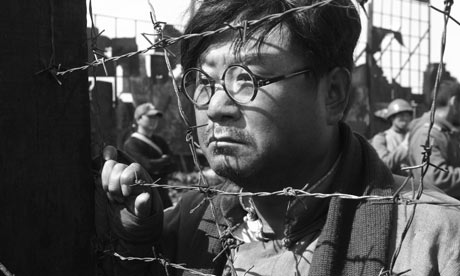City of Life and Death (2009) 

Director: Chuan Lu
Cast: Ye Liu, Wei Fan, Hideo Nakaizumi
Synopsis: In 1937, Japan occupied Nanjing, the Chinese capital. There was a battle and subsequent atrocities against the inhabitants, especially those who took refuge in the International Security Zone.
Chuan Lu’s City of Life and Death was never going to be anything less than a controversial film. An uncompromising recreation of the notorious ‘rape of Nanjing,’ during which up to 300,000 Chinese civilians and soldiers were murdered and an estimated 20,000 women raped by occupying Japanese troops. The fact that the movie was made in China at a time when that country was experiencing what amounted to an abhorrently mild-mannered condemnation of its own human rights record — China is the largest growing economy in the world, so it wouldn’t do for us outraged Westerners to protest too loudly — did little to leaven the controversy. The Chinese, meanwhile, were less than pleased at the positive light in which one of the Japanese characters – a soldier named Kadokawa (Hideo Nakaizumi) – was portrayed, and some even went so far as to issue online threats to the lives of the director and his family. Nice to see that lessons from the incidents portrayed in the movie have been learned on all sides, then…
The film is shot in black-and-white — presumably for artistic purposes because it adds little to our understanding or impression of the events it depicts — and takes a little while to reveal just who are its key characters. For a while it looks as if the story will alternate between the perspective of Kadokawa and Lu Jianxiong, a Chinese soldier who is captured by Kadokawa’s unit. This soldier snipes at the Japanese while a young boy, Xiaodouzi, provides him with whatever ammunition he can find. Both are captured, and his fearless, noble stance together with his comrades’ rebellious chants are a telling contrast to the thuggish, murderous behaviour of their Japanese counterparts. You could no more imagine this captured Chinese soldier acting in the same way as these Japanese invaders as you could picture yourself throwing a small child from a second floor window. However, Lu Jianxiong’s nobility avails him of nothing but a part as one of the targets in a mass execution which only the boy and Shunzi, a comrade of Lu Jianxiong, survive.
The man and boy make their way to the city’s Safety Zone, which is operated by Nazi businessman John Rabe and other Westerners, but the zone is anything but safe. Japanese soldiers regularly force their way into both the zone and its women, who are encouraged to cut off their hair and dress like men to avoid being raped. Meanwhile, Mr. Tang, one of Rabe’s assistants who collaborates with the Japanese in the misguided hope that his family will be spared from the atrocities taking place, finds his efforts have been wasted when his small daughter is murdered by a Japanese soldier, and his sister-in-law driven to madness after repeated rapes. While Rabe helps Tang search for his sister-in-law, Kadokawa grows increasingly disturbed by all the violence and abuse heaped upon the Chinese. He visits Xiaojiang, one of 100 women forced to serve as ‘comfort women’ for the Japanese soldiers, and gives her rice, but is distraught to see her dead body later being carried from the hall in which she was stationed, particularly as she reminds him of a Japanese prostitute whom he loves.
The atrocities visited upon the residents of Nanjing paints an unthinkable picture of a world gone mad, and present us with damning evidence of the frightening human capacity for evil when unconstrained by law or fear of repercussion. They are depicted in uncompromising detail in Chuan Lu’s film, stripped of sensationalism, with Yu Cao’s handheld camera either placed squarely in the thick of the action to record the terror and anguish of the abused, or filming from a distance to capture the full extent of the destruction wrought upon China’s ravaged former capital city by the brief war. And yet, apart from one truly shocking incident, the events depicted in City of Life and Death are never quite as shocking or harrowing as they should be. This might be because of the film’s undeniable propagandistic slant — rightly or wrongly, the feeling that our emotions are being cynically manipulated is never far away — or Chuan’s decision to film in black-and-white, which for some reason seems to distance us from events and prevent us from becoming fully immersed in what is taking place (But then Spielberg filmed Schindler’s List in black-and-white, and it was never an issue with that film). There’s no denying the power of the story, but it engages more on an intellectual level rather than emotional one. And having many of the atrocities witnessed through the eyes of a single Japanese soldier has an oddly counterproductive impact to that which was presumably intended. For the full horror to be realised, there needed to be more than one largely mute onlooker; there needed to be a cadre of objectors, even if they only voiced their abhorrence at their fellow countrymen’s behaviour amongst themselves, to prevent the entire Japanese nation being demonised the way they are here. There’s no doubting what took place in Nanjing in those few weeks in 1937, but it’s inconceivable that, amongst all those Japanese soldiers present, only one felt any revulsion at the behaviour he witnessed.
httpv://www.youtube.com/watch?v=9td_3P3w1S4
